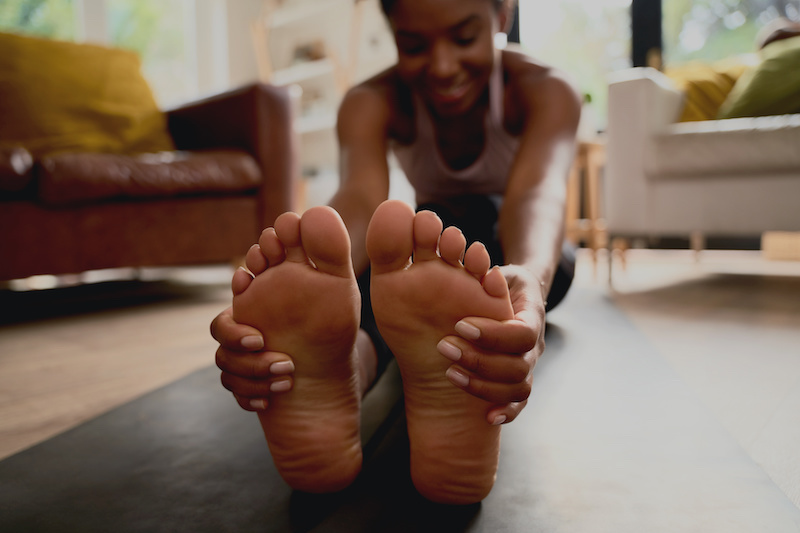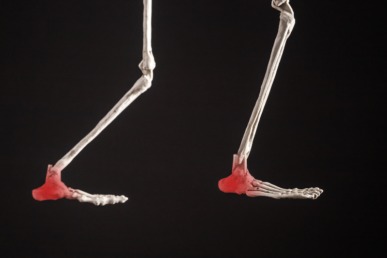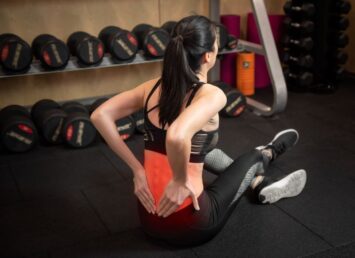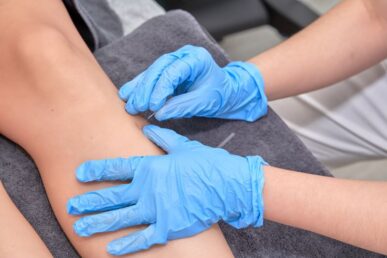Plantar fasciitis is a whole-body issue that requires a whole-body solution, which is why sports chiropractic is so effective at helping it. The chiropractic approach to healing is not just centered on pain relief, but in identifying imbalance and dysfunction wherever it is in the body that has resulted in foot and ankle pain.
Our care options for building strength and stability, increasing blood flow, and improving overall foot functionality to heal plantar fasciitis are non-invasive and don’t involve medications, injections, or surgical interventions.
But home care to complement in-office therapy is extremely important to completing rehabilitation. Below are several proven effective ways you can assist your sports chiropractic therapies and better encourage recovery from plantar fasciitis.
Lower Extremity Stretches
Tight, restricted calf muscles increase the strain on the plantar fascia, which both leads to overpronation of the foot and causes limited ankle dorsiflexion (the amount you can pull your toes toward your body.)
Regularly stretching the muscles in the calf and arch of the foot is good for both rehabilitation and prevention of foot pain, because it creates strength and adds stability to the area. Begin with gentle stretches based on your own personal flexibility level, and increase the tension as you establish your stretching routine. Repeat each stretch 10X per foot/leg beginning with one session per day and eventually increasing to two, preferably at the beginning and end of each day. Hold the stretches for 10-20 seconds before releasing.
Soleus Stretch (Calf Raises on a Step)
Stand upright with the front half of one foot on the edge of a step or curb. Slowly let the heel drop toward the ground until you feel a stretch along the back of the calf. This can also be done facing a wall by stepping one foot back and leaning into the wall until you feel a stretch.
Straight Leg Calf Stretch (Dorsiflexion Stretch)
Sit upright with legs stretched out in front of you, and, leaving legs on the floor, slowly pull/point the toes up toward the face until you feel a stretch along the back of the heel and leg. This can also be done facing the wall by pressing just the toes of one foot against the baseboard and leaning in for the stretch. This one can be done before even getting out of bed in the morning!
Anterior Tibialis Stretch
With one foot flat on the floor, place the top of the toes of the other foot on the ground and gently press until you feel a stretch in the top of the foot and up the shin. This can be done seated or standing.
Tripod Stretch
Begin on all fours and press the hips up into a tripod (triangle) position with knees bent. Tuck one ankle behind the other and slowly straighten the standing leg until you feel a stretch on the back of the ankle and calf.
Therapeutic Tools
There are a number of easily accessible, therapeutic tools that can help increase the strength and mobility of the foot. Foam rollers, mobility sticks, textured balls, and resistance bands are all great for encouraging the release of tight muscles and helping improve blood flow and flexibility.
Rolling out tight and sore muscles in the calf and hamstrings with a foam roller before and after stretching warms the muscles and increases blood flow. As a bonus, it assists the lymphatic system in flushing the body of toxins.
Placing a textured ball or TheraBand roller under the arch of the foot and rolling it back and forth stimulates the nerve endings on the bottom of the foot and increases blood flow to the area. This is easy to do while resting or watching television.
For those with severe pain and limited flexibility, resistance bands can assist in stretching. By placing bands around the toes and pulling the toes/bands toward the torso, patients can get a more passive stretch, but still effectively enhance dorsiflexion.
Orthotics
Plantar fasciitis pain from tight calf muscles and over-pronated feet can often be addressed with supportive shoes or other orthotics. While these types of aids don’t address the root cause of the pain, they do often offer some temporary physical relief when on your feet.
Turmeric Supplementation
It can be tempting to repeatedly reach for NSAIDs when struggling with foot pain, but plantar fasciitis can take weeks and even months to heal. Taking OTC anti-inflammatories for an extended period can have a host of side effects including gastrointestinal issues, disrupted hormone levels (especially in men), and a polluted microbiome. Just one week of taking NSAIDs as directed can increase your risk of stroke by adversely affecting an enzyme that promotes clotting!
In addition, NSAIDs can impair the ability to build muscle which can be counterproductive to the strengthening exercises involved in rehab, so it may actually slow the healing process.
Turmeric, on the other hand, improves the body’s ability to heal in a variety of ways.
* reduces systemic inflammation
* encourages collagen production to speed the healing of wounds
* fights oxidative stress on the body
* regulates mood (pain and depression often go hand-in-hand)
As with any form of supplementation, taking quality, bioavailable turmeric is key to experiencing noticeable improvements.
Lifestyle Changes
To create an optimal environment for healing in the body, no matter what the complaint, good lifestyle habits are important. Eat nutrient-dense foods. Aim to get plenty of quality sleep, and seek to relieve stress in positive ways.
Remember that successful home care for plantar fasciitis requires consistency over the entire healing period. When practiced diligently, especially in conjunction with sports chiropractic care, natural healing for foot pain is possible. Contact Dynamic Sports Medicine today to schedule an appointment. We can assess your situation and recommend which of these home therapies might best assist you on the road to recovery.





